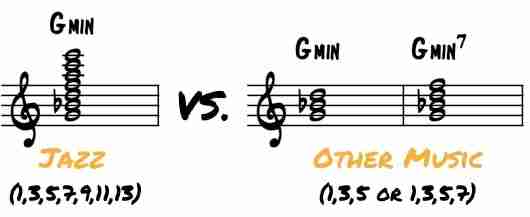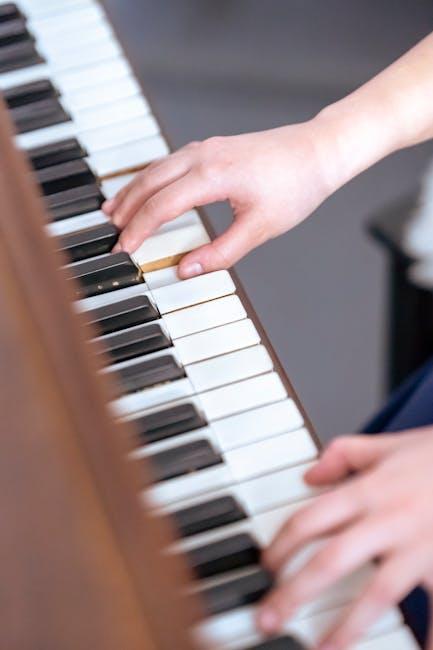Strumming along aimlessly on your guitar is like trying to solve a Rubik’s Cube blindfolded - frustrating and ultimately unproductive. But fear not, fellow music enthusiasts, for I have the key to unlocking the magical world of structured practice: mastering chords. So grab your instrument, tune those strings, and get ready to embark on a musical journey filled with harmony, melody, and a whole lot of chord progressions. Let’s dive in and discover the true power of chords in shaping your musical prowess!
Contents
- 1 Understanding the Foundation of Chords: Major and Minor Structures
- 2 Exploring Extended Chords: Seventh, Ninth, Eleventh, and Thirteenth
- 3 The Role of Chord Inversions in Creating Smooth Transitions
- 4 Applying Chord Progressions to Enhance Musical Storytelling
- 5 Incorporating Chord Substitutions for Creative Expression
- 6 Developing a Structured Practice Routine for Chord Mastery
- 7 Analyzing Songs to Identify and Practice Chord Usage in Context
- 8 FAQs
- 9 In Conclusion, No More ”Accidentals” in Your Practice Routine!
Understanding the Foundation of Chords: Major and Minor Structures
So you want to understand the foundation of chords, eh? Well, buckle up because we’re about to dive deep into the world of major and minor structures! Now, I know what you’re thinking – ”how can something as simple as a chord be so complex?” Well, my friend, prepare to have your mind blown!
Let’s start with the major chord, shall we? It’s like the party animal of the chord family – always bright, happy, and ready to shake things up! To form a major chord, all you need to do is stack a root note, a major third, and a perfect fifth on top of each other. Voilà! You’ve got yourself a major chord that’s bound to get everyone grooving.
On the flip side, we have the minor chord – the brooding, introspective sibling of the major chord. To create a minor chord, simply take a root note, a minor third, and a perfect fifth and stack ’em up. Suddenly, you’ve got a chord that’s perfect for those moody moments when you just need to wallow in self-pity for a bit. Ah, the beauty of contrasts!
But wait, there’s more! Major and minor chords are like the yin and yang of music – they complement each other perfectly and create the harmonious balance that we all know and love. So next time you’re strumming away on your guitar or tickling the ivories on the piano, remember the foundation of chords and how major and minor structures work together to create the magical world of music!

Exploring Extended Chords: Seventh, Ninth, Eleventh, and Thirteenth
So you’ve mastered your basic chords and you’re ready to level up your chord game? Well, you’ve come to the right place! Today, we’re diving into the world of extended chords – the sevenths, ninths, elevenths, and thirteenths. Trust me, once you start incorporating these juicy chords into your playing, there’s no turning back!
Let’s start with the seventh chords – the OG of the extended chords. With that added seventh note, these chords have a little extra spice and flavor that will take your music to the next level. Next up, we have the ninths – adding that ninth note brings a whole new dimension to your chord progressions. It’s like adding a sprinkle of fairy dust to your music!
Now, onto the elevenths and thirteenths. These chords are like the cool kids of the extended chord family. With those added notes, your music will sound so sophisticated that you’ll have people asking, “Are you sure you’re not a jazz musician?” So go ahead, experiment with these extended chords and watch your music soar to new heights!
The Role of Chord Inversions in Creating Smooth Transitions
Chord inversions are like the chameleons of the music world – they can blend in seamlessly and make everything sound smooth as butter. Imagine you’re driving down the highway in a convertible with the wind in your hair, and the radio switches from one chord to another. If those transitions were clunky and abrupt, you might spill your coffee all over that sleek leather interior. But thanks to chord inversions, you can enjoy your ride without any sudden jolts.
When it comes to creating smooth transitions, chord inversions are your best friend. They’re like the magician who can make a rabbit disappear without anyone even noticing. By flipping the order of the notes in a chord, you can move from one chord to another without missing a beat. It’s like a musical sleight of hand that keeps the listener on their toes, wondering how you managed to pull off such a flawless transition.
With chord inversions, you can create a sense of tension and release that keeps your listeners engaged. It’s like a rollercoaster ride of emotions – one moment you’re soaring high with a major chord inversion, and the next you’re plunging deep with a minor chord inversion. It’s all about taking your audience on a wild ride and keeping them guessing at every turn.

Applying Chord Progressions to Enhance Musical Storytelling
Picture this: you’re crafting a musical masterpiece, but something is missing. The melody is catchy, the lyrics are captivating, but it needs that extra oomph to really tell a story. Enter chord progressions, the secret ingredient to enhancing your musical storytelling!
With a cleverly chosen chord progression, you can take your listeners on a rollercoaster of emotions. Want to convey a sense of longing? Try **fading from a minor chord to a major chord**. Want to create tension and drama? **Use unresolved chords like the dominant 7th** to keep your audience on the edge of their seats.
Just like a good plot twist in a movie, unexpected chord progressions can add depth and intrigue to your music. Think outside the box and experiment with **modal interchange** or **borrowed chords** to keep your listeners guessing and engaged.
Remember, music is a language all its own, and chord progressions are the punctuation that help drive your story forward. So next time you’re composing a song, don’t forget to sprinkle in some **chord magic** to really make your musical storytelling shine!

Incorporating Chord Substitutions for Creative Expression
So you’ve mastered playing basic chords on your guitar or piano and you’re ready to take your music to the next level. Well, my friend, it’s time to unleash your creative genius by incorporating some funky chord substitutions into your playing!
Forget about playing the same old boring chords over and over again. With chord substitutions, you can spice up your music and add a touch of sophistication to your sound. Plus, your audience will be wondering, ”How does he/she make those crazy chords sound so good?!”
Here are a few tips to help you get started:
- Experiment with different chord voicings: Don’t be afraid to deviate from the standard chord shapes. Try playing chords in different inversions or variations to add some flavor to your music.
- Use chromatic passing chords: Want to add some tension and release to your chord progressions? Inserting chromatic passing chords between your regular chords can create a sense of movement and keep your listeners on their toes.
- Try substituting chords from the parallel key: Want to give your music a jazzy or bluesy twist? Replace some of your regular chords with chords from the parallel key. It’s like adding a dash of hot sauce to your musical soup!
Developing a Structured Practice Routine for Chord Mastery
So you’ve decided it’s time to tackle those tricky guitar chords and become a chord master, eh? Well, you’ve come to the right place! is no easy feat, but with a little bit of dedication and a whole lot of determination, you’ll be strumming like a rockstar in no time.
First things first, you’ll want to make sure you have all the necessary tools at your disposal. That means a trusty guitar, a comfortable seat, and maybe a snack or two for those particularly grueling practice sessions. **Let’s get down to business and break down the steps to :**
- Start with the basics: Warm up your fingers with some simple chord exercises to get those digits moving and grooving.
- Focus on one chord at a time: Don’t overwhelm yourself by trying to master every chord under the sun in one sitting. Take it slow and steady.
- Set goals: Whether it’s learning a new chord every week or being able to switch between chords seamlessly, having goals will keep you motivated.
Remember, practice makes perfect! So grab that guitar, set aside some time each day to dedicate to your chord mastery practice routine, and get ready to impress your friends and family with your newfound guitar skills. Rock on!
Analyzing Songs to Identify and Practice Chord Usage in Context
Ever struggled to figure out just what the heck chords a song is using? Don’t worry, you’re not alone. But fear not, dear reader, for we’re here to help you unravel the mystery that is chord usage in songs!
One way to get better at identifying and practicing chords in context is to start by listening to the song and identifying the chord progressions. This can be done by playing the song on repeat and following along with your trusty ol’ guitar or piano. It may take a few tries, but eventually, you’ll start to pick up on the patterns and progressions used throughout the song.
Once you’ve identified the chord progressions, the next step is to practice playing them yourself. Grab your instrument of choice and start strumming or plunking away. This is where the real fun begins! Try playing along with the song to see if you can keep up with the changes in chords. Don’t worry if you mess up – that’s all part of the learning process!
Remember, practice makes perfect. Keep analyzing songs, practicing chord progressions, and before you know it, you’ll be a chord-master extraordinaire! So go forth, brave musician, and conquer those tricky chords with confidence and gusto!
FAQs
What are some tips for mastering chords?
Well, first of all, don’t just rely on luck and unicorn magic. Practice, practice, practice! Make sure you’re using proper technique and don’t be afraid to slow down and really focus on each chord shape.
How can I make my chord practice more structured?
Create a chord progression or song that incorporates the chords you’re working on. This way, you’re not just mindlessly strumming random chords, but actually using them in a musical context. Plus, it’s way more fun than staring at a chord chart for hours on end.
What should I do if I’m struggling with a particular chord?
First off, don’t throw your guitar out the window in frustration. Take a deep breath and break down the chord into smaller, more manageable parts. Work on fingering each note individually, then try putting them together slowly. And remember, Rome wasn’t built in a day – neither is your chord mastery.
How can I stay motivated during chord practice sessions?
Reward yourself with a little treat every time you nail a tricky chord. Maybe a cookie, a high five, or a victory dance – whatever floats your boat. And remember, progress is progress, no matter how small. So keep at it, and soon you’ll be churning out chords like a pro.
Should I focus on practicing one chord at a time or multiple chords?
A little bit of column A, a little bit of column B. Mix it up! Practicing multiple chords in a row can help with smooth transitions, while focusing on one chord at a time can really help you nail down the muscle memory. Variety is the spice of life, especially when it comes to chord practice!
In Conclusion, No More ”Accidentals” in Your Practice Routine!
Congratulations! You are now well on your way to becoming a chord master! With structured practice and dedication, you’ll be strumming chords like a rockstar in no time. So go ahead, pick up that guitar, play those chords, and remember: no more “accidentals” in your practice routine – except, maybe, the occasional accidental F# or Gb. Keep on strumming!



